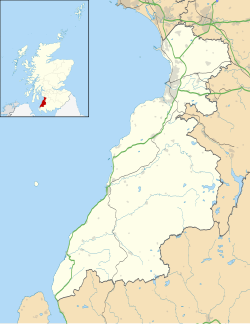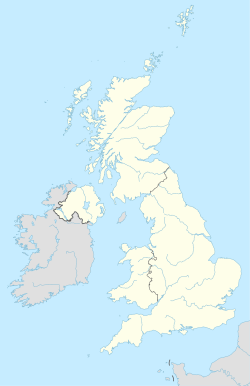RAF Turnberry was an airfield in Scotland used by the Royal Flying Corps (RFC) and the Royal Air Force (RAF) during the First World War, and again by the RAF in the Second World War. Between the two wars, the site reverted to its pre-1914 use as the Turnberry Golf Course and hotel. It reverted to this use again after the Second World War. Although there is still a disused landing strip, the site is now the Trump Turnberry.[2][3]
| RAF Turnberry | |||||||||||
|---|---|---|---|---|---|---|---|---|---|---|---|
| South Ayrshire in Scotland | |||||||||||
| Coordinates | 55°19′24″N 4°49′49″W / 55.32333°N 4.83028°W | ||||||||||
| Type | Royal Air Force station | ||||||||||
| Site information | |||||||||||
| Owner | Air Ministry | ||||||||||
| Operator | Royal Flying Corps Royal Air Force | ||||||||||
| Controlled by | RAF Coastal Command | ||||||||||
| Site history | |||||||||||
| Built | 1917 1940 | ||||||||||
| In use | 1917-1919 1940-1945 | ||||||||||
| Battles/wars | First World War European theatre of World War II | ||||||||||
| Garrison information | |||||||||||
| Occupants | 1 Fighting School (North-West Area) No. 618 Squadron RAF | ||||||||||
| Airfield information | |||||||||||
| Elevation | 11 metres (36 ft)[1] AMSL | ||||||||||
| |||||||||||
History
editFirst World War
editIn WWI Turnberry housed No. 1 School of Aerial Fighting (Loch Doon, to the east, was used for a School of Aerial Gunnery). The school merged with No. 2 (Auxiliary) School of Air Gunnery, becoming No. 1 School of Aerial Fighting and Gunnery, renamed No. 1 Fighting School (North-West Area) on 29 May 1918. It provided pilots with three-week courses in the arts of aerial gunnery and combat. It was disbanded on 25 January 1919. The Turnberry Hotel was used during the war as a hospital for the wounded.[4]
Inter war period
editFollowing the end of the conflict, all land and property requisitioned for military purposes was returned to civilian ownership. Golf courses 1 and 2 were rebuilt and renamed "Ailsa" and "Arran". A memorial honouring lost airmen at Turnberry was erected on the hill overlooking the 12th green of Ailsa.[5]
Second World War
editWith outbreak of the Second World War, the hotel was again commissioned by the British government as a hospital, and the golf courses were requisitioned for air training for the Royal Air Force.
In November 1942 the Torpedo Training Unit RAF arrived from RAF Abbotsinch in Glasgow. Two months later in January 1943 it became No. 1 Torpedo Training Unit RAF, and kept that name until May 1944.[6]
RAF Coastal Command based Consolidated Liberators there for anti-submarine patrols over the Atlantic. The base was also used for training Bristol Beaufighter and Bristol Beaufort crews. Testing of Barnes Wallis's "Highball" bouncing bomb was also performed by 618 Squadron, flying from Turnberry. As Turnberry hotel was used as a Royal Navy hospital, as many as 200 patients died at the base.[4] In 1943, Bruce Forsyth's older brother John, who was serving as a pilot in the RAF, was killed during a training exercise at the base.[7][8]
The following units were based at Turnberry:[9]
- No. 5 Operational Training Unit RAF (May - December 1942)[10]
- No. 10 Gliding School RAF (May 1945 - January 1948)[11]
- No. 254 Squadron RAF
- Coastal Command Flying Instructors School RAF (June - October 1945)[12] became Coastal Command Instructors School RAF (October - November 1945)[13]
References
editCitations
edit- ^ Falconer 2012, p. 198.
- ^ "Donald Trump adds his name to the Turnberry golf resort". BBC News. BBC. 16 June 2014. Retrieved 2 July 2014.
- ^ "Donald Trump's name 'will boost Turnberry'". BBC News. BBC. 2 July 2014. Retrieved 2 July 2014.
- ^ a b "Turnberry at War". SLC Turnberry Limited. 2016. Retrieved 9 January 2016.
- ^ Airmen's Memorial at 55°19′35″N 4°50′21″W / 55.3264°N 4.8393°W
- ^ Sturtivant, Hamlin & Halley 1997, p. 293.
- ^ Wintle, Angela (14 April 2012). "Bruce Forsyth: My family values". The Guardian. Retrieved 18 August 2017.
- ^ "Commonwealth War Graves Commission". Retrieved 19 August 2017.
- ^ "Turnberry". Airfields of Britain Conservation Trust. Retrieved 12 June 2020.
- ^ Sturtivant, Hamlin & Halley 1997, p. 234.
- ^ Sturtivant, Hamlin & Halley 1997, p. 163.
- ^ Sturtivant, Hamlin & Halley 1997, p. 93.
- ^ Sturtivant, Hamlin & Halley 1997, p. 94.
Bibliography
edit- Falconer, J (2012). RAF Airfields of World War 2. UK: Ian Allan Publishing. ISBN 978-1-85780-349-5.
- Sturtivant, R; Hamlin, J; Halley, J (1997). Royal Air Force flying training and support units. UK: Air-Britain (Historians). ISBN 0-85130-252-1.
External links
editThe Ayrshire airfield that helped shape the fledgling RAF Alison Campsie, The Scotsman, 31 March 2018.

